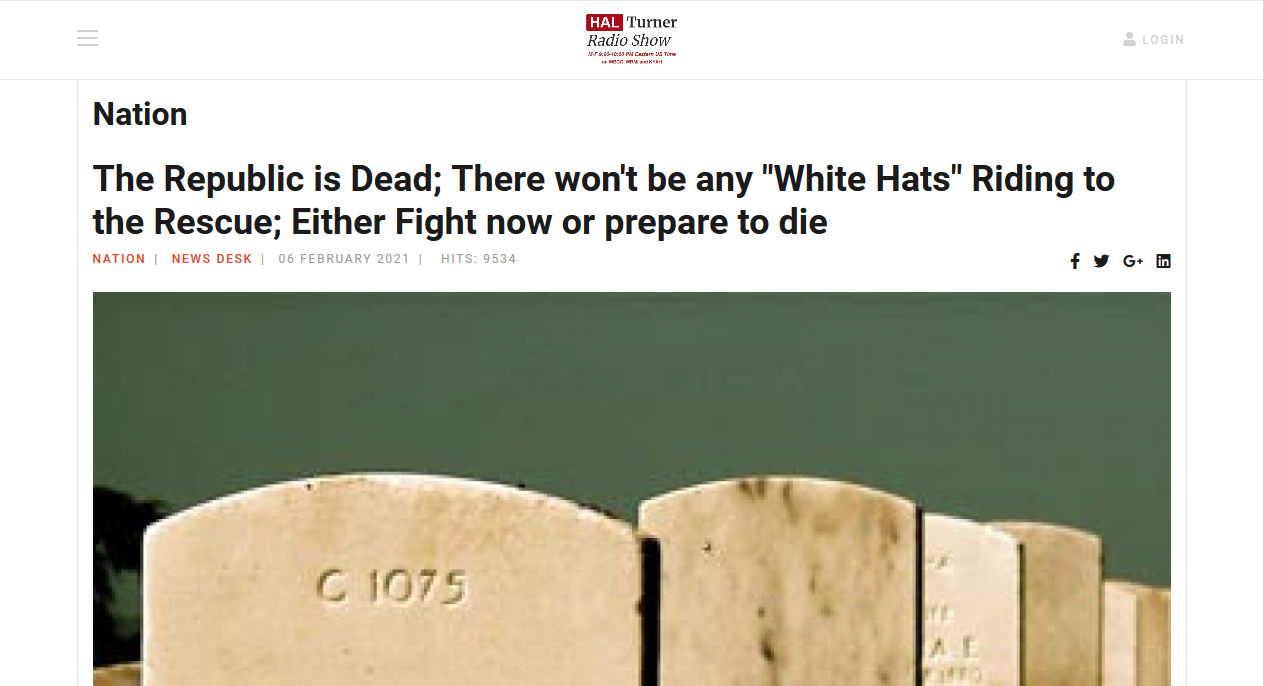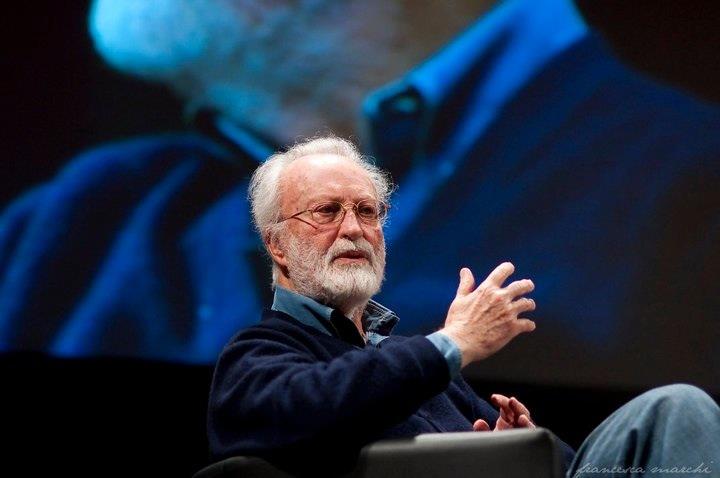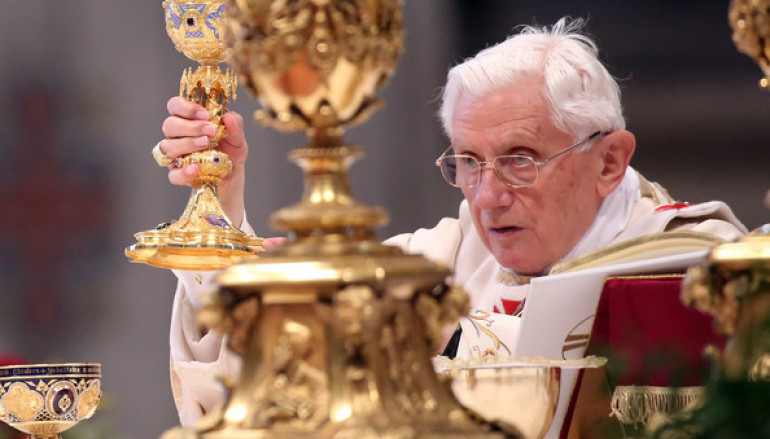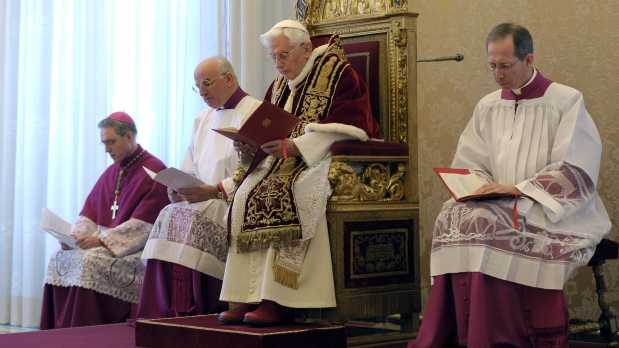Daily Archives: February 7, 2021
L’Italia sta fallendo e gli Italiani stano morendo! Ribelliamoci!
USA: The Republic is over, its Marxist Dictatorship or Rebellion!
Draghi vuole l’Italia servire all’Euro non al suo popolo
Father Gruner: Benedict did not resign the Papacy
https://youtu.be/kmtNJbcu2MA
This testimony argues strongly, that all who took Father Gruner seriously, would have held that Ann Barnhardt “was probably right”. — Just saying, Chris!
Long term use of Medical Masks may contribute to Lung Cancer
Vatican gives second dose of lethal Vaccine to Pope Benedict XVI
This report is unconfirmed, but if true it is truly a horrendous revelation. The Pfizer Vaccine is known to have as high or higher mortality rates as Coronavirus infections for the elderly, among those elderly who are frail like Pope Benedict XVI. As such, to administer it to the Holy Father is tantamount to deliberate premeditated homicide. — Click the image to read the story.
GOP in US House votes to keep back-stabbing globalist Cheney
Academics uncover link between Lavender Mafia and Pedo networks
This discovery should not be isolated to Australia. FromRome.Info has certain information which indicates that there are the same linkages in Europe and in other continents. Not a few of the Clergy who control Dioceses round the world were NOT recruited among men with vocations, but among men who are pedophiles. As such they do not represent the Catholic Church and should be removed from power. Laymen who dedicate themselves to this research are triply blessed by Christ the King, for the cleanse His House, defend His Name and protect His little ones everywhere!
Antonio Socci: “Cardinal” Scalfari reveals that Benedict is still the Pope!
What is Going on Inside the Vatican?
By Antonio Socci
First published by Libero, 6 December 2020
Original Title: Antonio Socci: “Cardinal” Scalfari “Reveals” that Benedict XVI is the Still Pope
At the age of 96, Eugenio Scalfari continues to bestow his pearls of wisdom upon humanity. And it appears that he wants to continue for a long time, because he is worried that the sun is going to burn out in less than 5 billion years.
In fact, in his writing that ranges from philosophy to literature, from politics to theology, he often ends his columns with a note of alarm that “the Sun – our guiding star – is getting old,” and even if “it will take millennia before we see a darkened sun” he, Scalfari, is worried. Apparently he thinks he will be present at the unpleasant event and is already thinking about what he will do.
Yesterday however he avoided his usual finale about the sun and, after writing about the relationship between Benedict XVI and Pope Bergoglio he ended with a surprise: “This is the future, and let’s not forget the elementary particles that revolve around the prince of Salina. We hope well.”
What does that have to do with anything? Is it an encrypted message? The usual, odd, literary evocation? To tell the truth, the entire article was surreal. However, given the personal relationship that Scalfari boasts of having with Pope Bergoglio (who at times seems to use their conversations to send messages about his highly advanced doctrinal positions), this piece is quite curious, also because Repubblica served it up on the front page with a very promising headline: “That understanding between the two Popes on the great themes of humanity.”
Scalfari opens solemnly: “In these hours an intellectual agreement is being confirmed of great interest in the Catholic Church and not only there. It is an agreement between two Pontiffs: Pope Francis and Pope Ratzinger.”
The article is accompanied by a photo of the two pontiffs at the consistory, but, apart from that photo (which does not mean anything other than a reciprocal courtesy), it is not clear what “confirmation” there was (and where and when) of an “intellectual agreement” since the pontificates of Benedict XVI and Pope Bergoglio are on diametrically opposed tracks, and also the pronouncements of Ratzinger, as pope emeritus, all follow the Catholic line of his pontificate and the pontificate of John Paul II: the polar opposite of the declarations and actions of Bergoglio.
Even “the great issues of humanity” on which, according to Scalfari, they supposedly agree, are not clarified, because they simply do not exist. For Benedict XVI the greatest tragedy of the present time is the cancellation of God, while for Bergoglio it is the climate….What could be more divergent…
Scalfari’s emphasis, however, is curious: Benedict XVI has “resigned from his former functions, but he is still the holder of his theoretical functions that will last as long as his life will allow him.”
I do not know if Scalfari realizes the theological complexity of the argument he enunciates and what a canonical mess it implies, but certainly it is significant if this concept comes from his conversations with Bergoglio.
Because it confirms that with his (mysterious) “step to the side,” Benedict XVI did not renounce the “Petrine munus,” and this opens enormous questions about what the current situation of the Church and the Pope is.
Scalfari even writes that “all the decisions of the highest importance that Popes can take will be and should be agreed to and actuated by both together.” But this has never happened in these eight years, and it would signify a shared papacy, a novelty of epochal importance.
Scalfari continues in an enigmatic way: he says that “a situation of this sort has never happened” (it’s true), but then he cites three names of popes as precedents (unless he is alluding to those of the Western Schism, and then this is a signal that it’s not flour from his own sack [Translator’s Note: i.e., that Scalfari’s material is being given to him by someone else].
He speaks of a “fraternal understanding between the two…already discussed for some time by the two present popes whose equality” would have been “recognized for some time in terms of thought, but not in such a formal and substantial way.” But what is he referring to? He is assertive, but he does not mention any public facts.
Scalfari adds that “today we can almost imagine the presence of two Popes who succeed in facing the great themes of humanity together.” Then he focuses on the theme of the Trinity, with an exhilarating finale about “diverse religions” for which “Francis and Ratzinger will share the task of having contacts.” The examples? “Think of the Waldensians, the Chinese, the Russians, the Irish, the Turks (are the “Irish” or the “Chinese” supposed to be religions?).
It’s difficult to make heads or tails of anything in the midst of such confusion. But perhaps “Cardinal Scalfari” has heard something. Bergoglio in fact has now exhausted his pontificate, which is now engulfed and dramatically divisive within the Church itself. Is it plausible that he is deluding himself with the idea of relegitimizing it in the coming months using the authority of Benedict XVI? Or in Bergoglian circles is there such a great fear of Benedict, whom an ever-greater number of believers sees as the “true pope” and the true lighthouse?
Scalfari reports confusedly on strategies that he has heard talk of, and he refers to the prince of Salina, the protagonist of [Tomasi di Lampedusa’s novel] Il Gattopardo,” which seemed pertinent to him. But what does he mean by “elementary particles?” Is this an allusion to indivisibility? What is happening inside the Vatican?
Translated by Giuseppe Pellegrino
CREDITS: Featured Image is CCASA 2.0 by Francesca Marchi / International Journalism Festival, source here.
Cannonades to liberate Pope Benedict XVI
NOTICE TO READERS OF FROMROME.INFO
FromRome.Info will publish 20 articles from now till Feb. 12, 2021, demonstrating that Benedict XVI is still the one and only true pope, and that Bergoglio was never, therefore, canonically elected.
You are encouraged to share all these articles on all social media platforms and through email with your friends and acquaintances, to spread the truth against the Masonic Big Lies of our days.
In this way you too can join in the greatest moral battle since Lepanto fighting on the side of Christ’s Vicar against the forces of barbarism and moral depravity!
FromRome.Info is the only publication in the English speaking world, and perhaps the only one in the entire world, which has marshalled in written format the entire canonical evidence and argumentation that Pope Benedict XVI is still the Vicar of Jesus Christ.
FromRome.Info is firing off this cannonade to urge the Catholic world to take action and free Pope Benedict XVI from the malign and polluted hands of the Globalists who drove him from power and keep him a prisoner in the Vatican. — By sharing these articles, you join battle on behalf of Pope Benedict XVI.
More Proof that Benedict was imprisoned by Masonic Alliance
Now they publish the names of the conspirators behind it all along.
Faith in the Most Blessed Sacrament leads to recognition of Benedict XVI as the Pope
by Br. Alexis Bugnolo
If you have the Catholic Faith, then you have the key to solving many of the most obscure controversies.
And if you have faith in the real, true, and substantial presence of Our Lord Jesus Christ, body, soul and Divinity in the Most Blessed Sacrament, then you have the key to know who is the true pope and who is a fraud an imposter.
And here is the key:
Just as the Host would not be consecrated if the priest said,
This is My athletic activity…
Rather than
This is My Body…
So, Pope Benedict XVI does not give up the papacy if he says,
I renounce my doing of the papacy,
Rather than,
I renounce the office of the papacy.
For on February 11, 2013, Pope Bendict in Latin said,
declaro me ministerio … renuntiare (I declare that I renounce the work of serving)
Instead of what Canon Law in canon 332 §2 says he has to signify,
muneri meo renuntio (I declare that I renounce the charge to serve which Christ gave me)
Now, some persons who think they are so bright that they can ignore this simply and irrefutable argument want you to fundamentally alter your religion, by denying that words have proper meanings. After 7 years you can see with your own eyes at Mass, if you still have the Mass, where that has led to.
Therefore, I exhort you: return to the rule contained in your faith in the Eucharist. Words do have meaning. And nothing happens if the wrong ones are used.
Click to help our brother Catholics in Lebanon!
Benedict’s End Game is to save the Church from Freemasonry
by Br. Alexis Bugnolo
Or, what Sherlock Holmes would say about the case of the Incongruous Renunciation
I have always been a fan of Sherlock Holmes, the fictional private detective in late Victorian England, created by Sir Arthur Conan Doyle, to popularize the new method of forensic investigation among the public police forces of his day.
As Sir Arthur writes in his Memoirs of Sherlock Holmes: “It has long been an axiom of mine that the little things are infinitely the most important”.
This maxim is actually something the great Scholastic Theologians of the Catholic Church would readily agree too, because they held that every individual effect is marked by its causes. Thus, every small detail about everything, says something about the causes of that detail. We have only to study the details to find the clues.
Here at the From Rome blog I have applied this method to the controversies over the vote rigging at the Conclave of 2013, which I have extensively examined. (You can see all the articles at The Chronology of Reports about “Team Bergoglio”), and to those about Benedict’s Renunciation (See the topical Index to Benedict’s Renunciation).
In this post, I want to share a lingering doubt I have about Benedict’s renunciation which I cannot shake, because it is seemingly confirmed by a host of details which have been overlooked by everyone, but which all point to the same conclusion, namely Benedict’s disgust with the College of Cardinals, not just as men, but as an institution.
Anomalies, Anomalies
As as translator of not a few Papal Bulls and Latin texts, when I examined the Latin of the Declaration of Feb. 11, 2013, the first thing which struck me was the the phrase ab his quibus competit. This phrase stuck me, because in Latin, which is a Language which is eminently laconic, it is a lot easier to write ab Cardinalibus electoribus. Why say, that the new supreme pontiff is to be elected by those who are competent to do so, and not by the Cardinal electors?
This question grows with a sense of significance, when you realize that Pope Benedict, according to the testimony of Archbishop Gänswein, wrote the text himself. And even more so, when you consider he wrote this text to be read out in the presence of the Cardinals themselves! In the refined halls of power, such a statement is much more than a faux paux, it is a positive insult and reproof. It is as if he is saying that the Cardinal Electors are not competent to elect a supreme pontiff. It is even more like saying, that his successor will not be elected by Cardinals at all!
This one small detail is something over which Sherlock Holmes would have had a panic attack of brain storming, because it is so incongruous of a statement to make in such a situation as a papal resignation, that it has to have causes which are not yet so obvious but which are crucial to understanding what happened and why it happened and what it all means.
I get a lot of guff and criticism for my speculations at this blog, mostly from those who do not appreciate the forensic method or the power of observation. As a trained anthropologist I understand why they do not understand and I understand why they are wrong in being oblivious to small facts. I know from the history of Archeology that entire theories of explanation of ancient, long lost cultures, were over turned by the finding of a single artifact, or a common artifact in a bizarre position or location. So I know professionally, that the methodology of Sherlock Holmes is not a fictional fantasy, but a real life powerful method of investigation and discovery.
If you find one anomaly, look for others
A single anomaly is hard to interpret, because as the Scholastics say, the individual which is the sole member of its species cannot be understood in itself. This means that when you find one anomaly, you need to look for more evidence and try to seek its causes. Other anomalies are the most important things to find, because then they establish a network of causes which can reveal the true meaning behind each anomaly. This is because it is harder to hide something in everything, than in a single thing.
The second anomaly which I noticed as translator of the Declaratio is that the Vatican had falsified all the vernacular translations. I reported this in the Article, The Vatican has known all along that Benedict’s Renunciation was invalid as written, and here is the proof. A brief summary translation of which, can be found in Italian at ChiesaRomana.info.
The obvious inference is that those who came into power after Benedict’s renunciation were trying to hide the evidence. But the less obvious inference is that Benedict wrote a renunciation which was obviously invalid and they were trying to hide the obviousness of it. And from that we can safely infer that there was a conflict between Benedict and whom he knew or suspected would come into power after his resignation. This final inference supports an understanding of the first anomaly, that Benedict was calling the Cardinal electors incompetent to elect a supreme pontiff.
This leads to an understanding which like a key can be used to decode the Declaratio. Now it is clear why Benedict calls himself the Successor of Saint Peter, but calls the one to be elected the new Supreme Pontiff. “Supreme” smacks of dictatorship and thus points to a Peronist. We can be certain that Benedict knew that Bergoglio was going to be elected because Bergoglio was the leading candidate in the previous conclave, and because Benedict was elected in opposition to Bergoglio. That opposition having crumbled in the College of Cardinals, it was obvious who would prevail. Benedict also as Pope had the resources of the Vatican spy network so he probably always knew what Bergoglio was up to prior to the conclave to suborn others and expand his power networks. The recent history of the European Bishops’ Conference, written by the the Bishop of St Gallen, shows that Pope John Paul II and Cardinal Ratzinger knew well of the existence of the St Gallen Group even before 1992. So we can be sure that Ratzinger maintained a dossier on them and kept his eye on them. We know now, that as Pope, most of his Pontificate was in preaching against the very errors, heresies and deviations which Bergoglio is now promoting. We know this by comparing what he was teaching with what Bergoglio is teaching, and it is a direct contradiction of it.
From all this, then, we can say decisively and with great certitude that the Declaratio was written to oppose the St Gallen Mafia and to lay down a maneuver against them. It was not a surrender, but it was made to look like a surrender. I explained my theory about this in the Article entitled, How Benedict has defeated “Francis”.
And because this was its primary motivation, for it to be successful Benedict had to decide from the beginning to be extremely discrete and divulge his intention with no one, not even Gänswein. I have long thought that this inference was improbable, but I recently obtained proof that Pope Benedict does not tell his private secretary everything, in the video prepared by Bavarian State TV, entitled, Ein Besuch bei Papst Benedikt XVI. em. Klein Bayern im Vatikan, which aired on January 3 in Germany. For in that video, Benedict reveals that there are things in his office of which he never told the Archbishop. And the Archbishop expresses both surprise and dismay.
The Crown of all Anomalies
It was only, however, when I took it upon myself to examine the Latin text with the eye of a Latin teacher correcting the homework of a student, that I found the crown of all anomalies. Yes, I found more than 40 grammatical, syntactical and stylistic errors. So many that it seemed to me impossible a pope could write such a thing. Either he was handed it to be signed, or he wrote it in haste, or he intentionally made it sloppy Latin to conceal something from obvious view. For, if you have ever watched British TV, and were a fan of Doctor Who, then you know, that the best place to hide a key is on a wall designed to hang dozens of keys, for there you can not only hide it in plain view, but hide it in such a way that it cannot be found or stolen.
And thus I was led to infer that Benedict was hiding something in the text, something more than just an invalid resignation of ministerium instead of munus. So I re-read the text and looked for anomalies, and now I wish to speak openly of what I found, of which I did not speak openly before in my Articles entitled, Clamorous Errors in the Latin Text of the Renunciation and A Nonsensical Act: What the Latin of the Renunciation really says.
And Benedict hid this anomaly right up front, in the place you would least expect to hide anything. I refer to the very first sentence of the Declaratio:
Non solum propter tres canonizationes ad hoc Consistorium vos convocavi, sed etiam ut vobis decisionem magni momenti pro Ecclesiae vita communicem.
As I said before, I have always thought it significant that Pope Benedict was promoting the study of Saint Bonaventure’s Scholastic Theology more and more during the later years of his Pontificate. That Doctor of the Church is an expert on the interpretation of textual statements. But that Doctor of the Church has his own way of using Latin. So being the translator of his Commentarii in Quatuor Libros Sententiarum, I just happened to have a great familiarity with the Latin of Bonaventure. And that made me see something of which I think no other has taken notice.
It is the word decisionem.
Latinists were focusing on the word immediately prior to this, vobis, because the Latin verb communicem takes an object with the preposition cum and thus requires vobiscum not vobis.
They then proceeded to simply fault Benedict for his poor choice of words, in writing decisionem instead of consilium. And in my critique I reported their opinions of this matter.
But what I did not report is my shock at the seeing the word decisionem, because in the writings of Bonaventure this word always means a “cutting off”, and has the sense of an amputation or pruning, as is done to a vine. Recall that in Scripture, Our Lord Himself says that He has to occasionally prune His people to take away dead branches and promote regrowth and fruitfulness. If you know anything about Joseph Ratzinger, then you know that as a theologian he likes to weave discourses around the meanings of Biblical images and words. Thus, one is led to the conclusion that he chose decisionem for reasons more significant than apparent.
If you combine that meaning with vobis and ignore the presumption that the latter was intended as vobiscum, the entire meaning of the sentence changes to something so radically unexpected, that only one having unraveled the chain of inferences and made a study of the anomalies in the text could possibly be prepared to accept that Benedict might indeed have meant that which the Latin actually says. Which is as follows:
Not only for the sake of three acts of canonizations, have I called you to this Consistory, but also for the sake of the life of the Church to communicate something of great importance: your being cut off.
As I just said, this reading seems incredible, but it explains all the anomalies which I have heretofore found in the text and in the history of the Renunciation. The purpose of the Declaratio was NOT to renounce the papal office, it was to Uproot the College of Cardinals as an institution from the Church, so as to save the Catholic Church from the complete Masonic infiltration of that institution.
We know now, seven years on, that the College of Cardinals has shown perfect compliance with the Freemasonic regime of Jorge Mario Bergoglio, and even its most conservative Cardinals have pledged unswerving loyalty to that regime. We also know that it has been a century long project of Freemasonry to infiltrate the College so as to take over the Catholic Church from the top down. We also know that Pope John Paul II and Benedict XVI were well informed by Saints and private revelations of the coming battle with the Anti-Church and False Prophet. Finally, we know that both collaborated decisively to renew the canonical penalties of excommunication against Freemasons in the Church (Declaration on Masonic Associations, Nov. 26 1983.) in forma specifica, that is, in the most solemn and authoritative manner of an express Papal approbation of a notice given the Congregation for the Doctrine of the Faith, headed by the then Cardinal Joseph Ratzinger.
It makes sense, then, if you know a key fort containing the greatest treasure of your kingdom is going to fall to the enemy, because of a complete treachery and rebellion of the military commanders holding it for you, the wisest council is to allow it to fall, without advising those commanders, while secretly removing the treasure, so that they are deceived in thinking they have triumphed and so that your removal of the treasure can be conducted in safety and during the confusion of their gleeful and exuberant seizing of the fort.
And this is what it seems Benedict did and intended to do. It also explains why Benedict acts the way he does and refuses to clarify his situation. Why he does not even take the Archbishop into his confidence. It also explains a lot of other things, which did not seem entirely anomalous before. For example, in his final year of pontificate, he made both Muller and Ganswein Archbishops, but not Cardinals, as if for his closest of friends he somehow did not want them to be members of that College.
If all these observations and inferences are correct, then one can with great probity conclude that it is the intention of Pope Benedict that after his earthly demise, that the Church of Rome, and not the College of Cardinals, who are held fast in a solidarity of dissent with Bergoglio, elect his successor: a thing about which I speculated about in my Article, Whether with all the Cardinal electors defecting, the Roman Church has the right to elect the Pope? And a thing of which even Pope John Paul II alludes in a most cryptic manner in the papal law on conclaves in his introduction, where he says, that it is a well established fact that a conclave of Cardinals is not necessary for a valid election of a Roman Pontiff (Universi Dominici Gregis, Introduction, paragraph 9).
Indeed, a study of the history of papal renunciations and the canons of the Church shows, that it was Pope John Paul II, in 1983, who by adding munus as the canonically required object of the verb “renounce” in canon 332 §2, actually created the canonical possibility of an invalid renunciation in the case of a pope who renounced something other than the petrine munus! A very small alteration, but one which not only prevented the office from being shared, according to the loony and heretical speculations of German theologians, but allowed a Roman Pontiff to give the appearance of a valid resignation, so as to deceive the forces of Freemasonry in the Church.
Now all this seems absurdly immoral, but in truth it is neither illegal nor illicit. For since the man who is the pope has the canonical right to renounce the petrine munus, it follows ex maiore that he has the moral right to renounce anything less than the munus. In cases of grave threat, he also has the moral right to dissimulate. Thus by renouncing the ministerium, not the munus, Pope Benedict posited an act which power hungry men without respect for the law or for the truth or for the person of the pope, would overlook during their rush to convene an invalid conclave. And thus their own fault and sin and haste would result in their canonical separation from the Church through an act of schism and usurpation. Yet, by renouncing the ministerium and not the munus, as required by Canon Law, Pope Benedict left sufficient evidence for all the Catholic faithful in the world to discover the truth, a thing of which he was confident they could do, because the quasi soul of the true Church is the Holy Ghost, the Lord and Inspirer of all truth, Who guides His faithful always to and in the truth.
In this way, both Pope John Paul II and Pope Benedict XVI have acted with great foresight and angelic prudence over the last 4 decades to enable that the Office of Saint Peter pass, not through the hands of men who have betrayed Christ en masse, but through the hands of the faithful of the Church of Rome, who precisely on account of their fidelity to the Roman Pontiff according to the norm of law, recognize what he has done and why he has done it.
+ + +
[simple-payment id=”5295″]
Conferenza per 449° Anniversario della Battaglia di Lepanto
Questa conferenza è stata svolto in Ottobre scorso. Gli interventi sono di Diego Fusaro, Frà Alexis Bugnolo e Magdi Cristiano Allam. Dura 2:12.
Diego Fusaro è critico del pensiero dominante globalista. Egli ha parlato della corruzione della politica sia nello Stato sia nella Chiesa da globalismo.
Frà Bugnolo è presidente del partito politico cattolico, L’Italia per gli Italiani. Egli ha parlato dalle Logghi Massonici della Città di Novo York e come controllavano tutta la storia del Mondo e della Chiesa durante il secolo passato.
Magdi Cristiano Allam è convertito dal Islam, battezzato da Papa Benedetto XVI. Egli ha parlato sulla minaccia di Islam in Europa.
Sulla tavola è una riproduzione autentica della bandiera di Marcantonio Colonna ammiraglio principale delle forze navali di Lepanto. (La bandiera è in vendita qui.) — Il 7 Ottobre 2021 sarà il 450 Anniversario della Battaglia di Lepanto.
CREDITS: Questa è la versione registrata dal Partito, L’Italia per gli Italiani.












